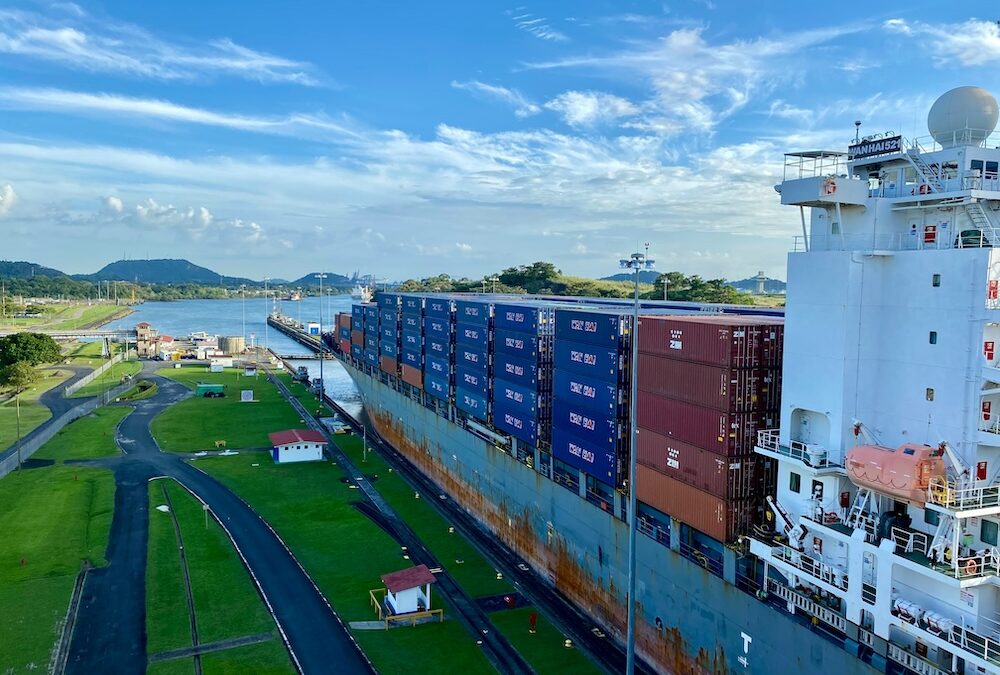As we’ve reported again and again, the world of international shipping is dynamic. That means staying ahead of the curve is imperative to ensure business success. Currently, one of the biggest issues affecting global trade is the surge in wait times at the Panama Canal. This challenge at a vital waterway route is leading to delays for many shippers.
Back in September, we shared the issue of wait times at the canal. Unfortunately, the situation isn’t getting better; in fact, it’s getting worse. Let’s explore the reasons behind these ongoing wait times.
Why the Surge Is Happening
The Panama Canal is a direct and vital passageway between the Atlantic and Pacific Oceans. When wait times at the canal increase, the entire industry feels it. Previously, a historic drought led to lower water levels, water which is needed to lift ships through the locks of the canal. Now, compounding the effects of the drought are vessels without reservations attempting to get through the canal.
In November, the Panama Canal Authority cut the number of ships allowed to travel through the waterway because of the drought. Since then, the number has dropped from 32 to 24 and then to 22. It’s currently being reported that the number will be further reduced to 18 by the first of February. Along with that reduction in passages comes an increase in wait times. It started at 2.1 days, on average, in November, and that’s expanded to an average of 11.4 days, more than triple the prior number.
The situation is coming to a head because carriers aren’t choosing alternate routes, opting instead to wait at the entrance to the canal—without reservations.
Which Ships Are Affected?
Ships going through the older Panamax locks are suffering the longest delays. Vessels using the newer locks, Neopanamax, haven’t been waiting longer than 11 days, whereas those looking to traverse the Panamax locks can expect waits up to 25 days. Regardless which route ships need to take—determined by size of vessel—those without reservations continue to vie for spots.
The Effects of Wait Times at the Panama Canal
Extended wait times have far-reaching implications for businesses engaged in international trade. Understanding these implications is essential for making informed decisions and developing effective strategies to navigate the current challenges. Some of these include:
Supply Chain Disruptions
When ships can’t traverse the Panama Canal, it naturally leads to supply chain delays and disruptions. Businesses that use this throughway may face challenges managing inventory levels and meeting production schedules.
Increased Costs
Given the delays to get through the canal, vessels are left waiting. The longer they wait, the more costs rise. These expenses include fuel, ship maintenance, and even labor as crew remain onboard longer than expected.
Market Competition
If one company’s products won’t arrive on time, consumers may opt instead to choose another company to fulfill their needs. By not planning ahead to navigate such shipping delays, companies can be at a disadvantage compared to their competition.
Options for Dealing with Shipping Delays
To effectively navigate the challenges posed by the tripled wait times at the Panama Canal, businesses need to adopt proactive measures and strategic planning. Here are some actionable insights for decision-makers:
Diversify Shipping Routes
One of the best ways to ensure products are received in a timely manner is to choose more than one shipping route. When companies rely on a single passage, they encounter an impasse during such challenges. It’s always better to have a plan B.
Use Advanced Logistics Technology
Leveraging technology is key to success, especially in today’s digital age. Logistics technology enables companies to optimize supply chain visibility and streamline operations. These include real-time tracking, predictive analysis, and automation.
Choose a Freight Forwarder Partner
Staying abreast of the ongoing issues and changes in the shipping industry can be a full-time job. Instead of tasking someone in the team who is perhaps unqualified, this is a job better outsourced to a freight forwarder. These professionals have a deep understanding of the current shipping landscape and can provide valuable insights, alternative solutions, and assistance in navigating the complexities of international trade.
Stay Informed and Plan Ahead
Whether you choose to read trade magazines or partner with a freight forwarder, remaining up-to-date on the shipping industry is a necessity for current exporters and importers. Knowledge enables companies to proactively adjust their strategies and make informed decisions to mitigate the impact of extended wait times.
The Benefits of Partnership
Tripled wait times at the Panama Canal represent significant challenges for businesses engaged in international trade. However, with some strategic planning and a strong partnership with Cyclone Shipping, an experienced freight forwarder, you can navigate these—and future—issues and emerge stronger. As the situation at the Panama Canal continues to unfold, adaptability and informed decision-making will be the keys to success in the ever-changing landscape of international trade.
Learn more about how Cyclone Shipping can help.




